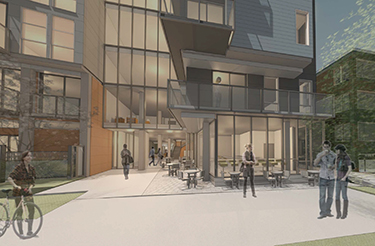|
Subscribe / Renew |
|
|
Contact Us |
|
| ► Subscribe to our Free Weekly Newsletter | |
| home | Welcome, sign in or click here to subscribe. | login |
Real Estate
| |
 |
December 12, 2013
Survey: Barrientos LLC
Specialty: Development of and investment in urban infill multifamily residential; development of cultural arts facilities
Management: Maria Barrientos, managing partner
Founded: 1999
Headquarters: Seattle
Projects: Rubix, a 73-unit high-end apartment building on north Capitol Hill (starts in February); Lexicon, 38 high-end apartments behind Dick’s Drive-In on Capitol Hill (completion in July); Hollywood Lofts, 24 two-story loft apartments also overlooking Dick’s and across from the future Capitol Hill light rail station (starts in January)
Q: What are the biggest trends and issues in your industry locally?
A: More of us developers are looking at multifamily housing as a consumer product that needs to be well designed and well thought-out. With the influx of so much product we need to be cognizant of different ways to differentiate ourselves and attract tenants.
One big trend that I love is that in-city developers are paying more attention to who their commercial tenants are as we all understand how big an impact the retailers have on a building’s identity.
Another trend is how tenants use the building’s amenity spaces. The need for more areas for folks to hang out and socialize and the ability to have Wi-Fi in these spaces is important.
There’s also consumer interest in “different” designs and finishes, in sustainability, etc.
Additionally, the requirement to compost in multifamily buildings is great and has changed the way we manage a building and how trash is used.
Package delivery is another big change. Forty percent to 50 percent of tenants receive a package every day from online shopping.
Q: Where will growth come from in the next few years for your firm and/or for your industry locally? What markets is your firm entering or exiting?
A: Growth in multifamily housing continues to come from in-migration from new jobs created as well as an extension of the ages of renters, from 25- to 34-year-olds to 24- to 39-year-olds.
It is important to realize that the millennials, as they are called, comprise a larger number of people than baby boomers. This group is less interested in home ownership and tends to rent for a longer period of time. My firm will remain focused on in-city urban infill multifamily housing development.
Q: Any ideas how Seattle can create more affordable housing?
A: Lower the cost of land, stop adding to building code/energy code requirements, and reduce the time it takes to obtain permits — all which drive up costs.
Develop a better public transportation system so developers don’t have to include so much costly below-grade parking in their projects.
Continue to incentivize developers to add affordable housing to 20 percent of all the product they build.
Increase density/height to 40 or 50 feet in the lowrise zones — especially surrounding dense neighborhoods like Queen Anne, Capitol Hill, Eastlake, Fremont and Wallingford — in return for including affordable housing in the projects.
Continue to allow more micro-housing as a housing alternative.
Q: Do you think modular housing will affect architecture, landscape architecture and urban design locally?
A: It shouldn’t affect it. In my opinion these units are just pre-made — traditional wood-frame construction made in a factory. The exterior, landscaping and placement on a site should all remain relevant as design factors.
Q: What are clients/customers asking for now versus five or 10 years ago?
A: I consider the clients to be the tenants of the properties. They are asking for hard floor surfaces, stainless appliances and large windows.
Marketing efforts and tenant outreach/retention have really amped up.
Other Stories:
- Empty strip mall? Here’s how to fill it
- Survey: Urban Visions
- Survey: Thomas Co.
- Survey: Wright Runstad and Co.
- Survey: Flinn Ferguson
- Survey: Lake Union Partners
- Survey: Schnitzer West
- State of the Market: Fledgling tech likes ‘gritty’ office buildings
- State of the Market: Is a banner year on tap for industrial properties?
- State of the Market: Retailers cash in on strong local market
- State of the Market: Multifamily rides Seattle’s strong job market
- Easements: Not just for highways and driveways
- 40-year-old plan could amp up downtown livability
- Commercial property owners deal with rising flood insurance
- Survey: Wallace Properties



